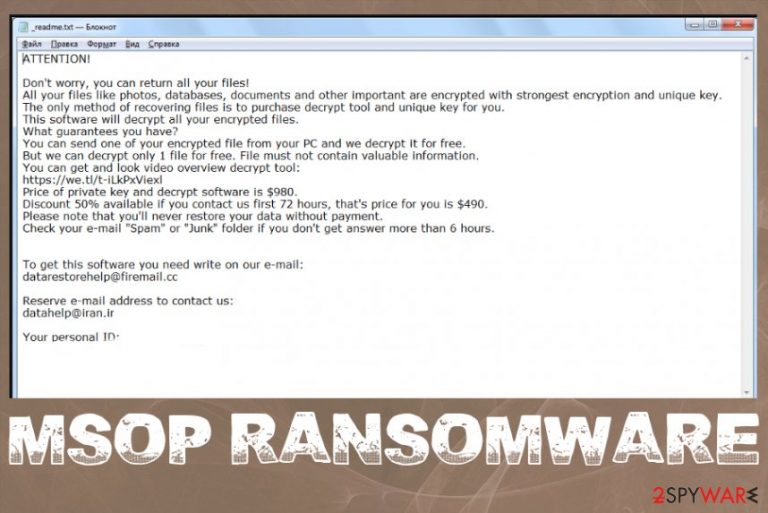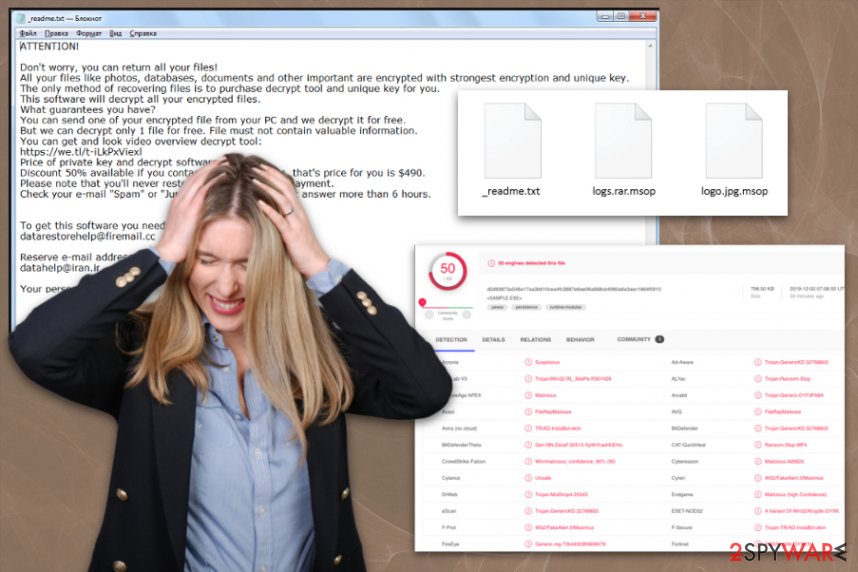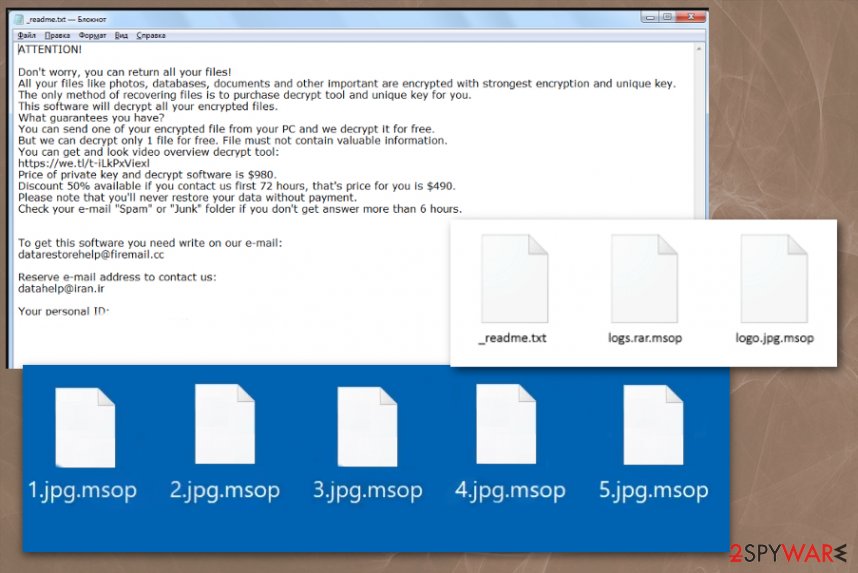Msop ransomware (Free Guide) - Decryption Methods Included
Msop virus Removal Guide
What is Msop ransomware?
Msop ransomware is the threat that frustrates users when they cannot open documents, photos or videos marked with .msop extension

The changes made by Msop ransomware virus developers back in August affected these decryption possibilities significantly because when data gets locked using the proper algorithm and online keys are employed, tools like STOPDecrypter cannot work for victims as it worked before. The best option for this .msop file appendix using version – virus removal, system cleaning, and then file recovery using your data backups. It takes a long time for researchers to develop decryption tools based on new changes of code, but it is exceptionally difficult when versions come out one after the other. Some experts speculate that the new Djvu decryptor that could help with all the versions might never get released.
| Name | Msop ransomware |
|---|---|
| Family | Djvu/STOP virus |
| File marker | .msop is the appendix that goes on every affected photo, document or video file after the data-locking process |
| Ransom note | _readme.txt is the text file that contains ransom note from cybercriminals with a payment demand |
| Contact emails | datarestorehelp@firemail.cc and datahelp@iran.ir |
| Symptoms | This virus loads on the system and starts the attack immediately with encryption, so your files get locked and marked, and you can be more encouraged to pay for the recovery. After this and the direct ransom demand, various system functions or features get either disabled or interfered with, so malware runs for a longer time on the system |
| Danger | Malware runs in the background and affects the various processes of the system, it can also damage many parts of the device permanently or infect the PC with additional threats. Contacting these people can lead to loss of money and data or more serious issues with your privacy and sensitive information |
| Distribution | This is the virus family that, in most cases, is distributed via infected files pre-packed with pirated software or as email attachments |
| Elimination | You need to remove Msop ransomware using anti-malware tools because only such software can find malicious files and delete them completely |
| Cleaning tip | Unfortunately, the antivirus application cannot help you with all encoded data or damaged system files. System optimization tools like FortectIntego might indicate those issues, corrupted system data, and fix the virus damage. As for file recovery, check the methods listed below. |
Msop ransomware is the intruder that falls into the category of cryptovirus because it employs the AES-256 algorithm[2] for encryption and demands direct payment from the victim in a _readme.txt file which gets placed on the desktop, in other folders with encrypted data. This file is the direct message from virus developers and encouragement to pay within 72 hours because the initial sum of $490 doubles after that.
Msop ransomware ransom message reads the following:
ATTENTION!
Don’t worry, you can return all your files!
All your files like photos, databases, documents and other important are encrypted with strongest encryption and unique key.
The only method of recovering files is to purchase decrypt tool and unique key for you.
This software will decrypt all your encrypted files.
What guarantees you have?
You can send one of your encrypted file from your PC and we decrypt it for free.
But we can decrypt only 1 file for free. File must not contain valuable information.
You can get and look video overview decrypt tool:
https://we.tl/t-4NWUGZxdHc
Price of private key and decrypt software is $980.
Discount 50% available if you contact us first 72 hours, that’s price for you is $490.
Please note that you’ll never restore your data without payment.
Check your e-mail “Spam” or “Junk” folder if you don’t get answer more than 6 hours.To get this software you need write on our e-mail:
datarestorehelp@firemail.ccReserve e-mail address to contact us:
datahelp@iran.ir
The text is pretty polite and can be encouraging for the victim, but paying is not a good idea. Experts[3] recommend ignoring the message and Msop ransomware developers altogether by deleting the threat as soon as possible and cleaning the machine from any traces, so the file recovery is not ending badly. If you load new files, replace encoded ones with safe copies, you risk getting those additionally encrypted when the machine is still affected by the ransomware.
Msop ransomware is the virus that can gain access to stored data or any saved information on the PC, so your personal information is at risk. Additionally, this family is known for loading the Windows Update window on the screen that shows the fake process of updating to hide the encryption and secondary payload dropping. AZORult trojan or info-stealing malware of any sort can easily find the way on your machine and obtain details for later scamming campaigns and even identity fraud.
You need to get rid of the threat, remove Msop ransomware itself and associated data, core files, to keep the machine clean and not affected by silent malware. Do that as soon as possible and use professional AV tools, so cryptovirus gets terminated, and additional malware cannot find the way on your system yet. 
You need to get a proper system tool or cleaner for the virus damage cleaning after initial Msop ransomware removal. FortectIntego may find, indicate, and repair Windows files, data in other system folders, or Windows Registry entries that get corrupted by the ransomware. This step is important for your device because repairing some functions of the PS can provide more options for data restoring.
There are no particular options for decryption of the Msop ransomware virus, but decryption tools for previous Djvu virus versions get updated often. Decryptor from Emsisoft research team is designed to decrypt versions released before August 25th of 2019 when the changes of code and encryption method were made. Nowadays virus developers make variants strictly using online IDs for their victims, so each person needs to get their unique decryption key for the proper file resorting.
Previously, Msop ransomware virus victims got their data recovered because offline IDs helped many victims at the time. One key got used for many victims, and StopDecrypter decrypted many systems. Now each victim needs to get the decryption key or possibly wait for any updates to the encryption of the virus or decryption tool release.
The best scenario would be to get these databases of virus developers leaked or hackers caught by law enforcement, but this is less likely to happen. You can store those encrypted files, some malicious data from the machine on an external device, and try to wait for any decryptor updates, but terminate the Msop virus before you get back to using the affected PC again. 
Shady distribution methods include malicious files and payload droppers
The internet is a place for anyone because you can find music, movies, software, and even love online. However, this is a very dangerous place too because malicious actors, criminals, hackers, other malicious people can find you and your device to run their activities.
When you browse various sites, some of them may be malicious copies of the real versions, so pages get filled with malicious scripts that trigger downloads of software or files. Also, malicious spam email campaigns include such things as malicious documents as attachments or pirated software packs install the virus as an extra download.
You need to pay attention to details like company names on emails, subject lines, services you use to get important applications, anti-malware software or games, documents. Stay away from cracks, cheatcodes, and licensed versions of programs distributed fo free. Such files have all the red flags you need to avoid.
Make the system virus-free and secure again by terminating Msop ransomware virus completely
Msop ransomware virus is the threat developed by the malware experts because criminals who manage the distribution of the ransomware released 180 more infections based on blackmail and extortion. Since the threat is not that new there are no vulnerabilities or flaws that may help for malware researchers to tackle the termination.
You need proper anti-malware tools for the best Msop ransomware removal results because AV detection engines can find malicious files, programs, and other malware associated parts on the machine to delete them completely and end the activity of this file-locking virus.
Unfortunately, to make the system virus-free you need to remove Msop ransomware and also run a few other processes. Security tools like SpyHunter 5Combo Cleaner, or Malwarebytes can help with virus elimination, but you need to get a system tool like FortectIntego which can find and repair Windows files affected or even damaged by the infection.
Getting rid of Msop virus. Follow these steps
Manual removal using Safe Mode
Reboot the machine in Safe Mode with Networking, so you can launch the AV tool and get rid of the virus completely
Important! →
Manual removal guide might be too complicated for regular computer users. It requires advanced IT knowledge to be performed correctly (if vital system files are removed or damaged, it might result in full Windows compromise), and it also might take hours to complete. Therefore, we highly advise using the automatic method provided above instead.
Step 1. Access Safe Mode with Networking
Manual malware removal should be best performed in the Safe Mode environment.
Windows 7 / Vista / XP
- Click Start > Shutdown > Restart > OK.
- When your computer becomes active, start pressing F8 button (if that does not work, try F2, F12, Del, etc. – it all depends on your motherboard model) multiple times until you see the Advanced Boot Options window.
- Select Safe Mode with Networking from the list.

Windows 10 / Windows 8
- Right-click on Start button and select Settings.

- Scroll down to pick Update & Security.

- On the left side of the window, pick Recovery.
- Now scroll down to find Advanced Startup section.
- Click Restart now.

- Select Troubleshoot.

- Go to Advanced options.

- Select Startup Settings.

- Press Restart.
- Now press 5 or click 5) Enable Safe Mode with Networking.

Step 2. Shut down suspicious processes
Windows Task Manager is a useful tool that shows all the processes running in the background. If malware is running a process, you need to shut it down:
- Press Ctrl + Shift + Esc on your keyboard to open Windows Task Manager.
- Click on More details.

- Scroll down to Background processes section, and look for anything suspicious.
- Right-click and select Open file location.

- Go back to the process, right-click and pick End Task.

- Delete the contents of the malicious folder.
Step 3. Check program Startup
- Press Ctrl + Shift + Esc on your keyboard to open Windows Task Manager.
- Go to Startup tab.
- Right-click on the suspicious program and pick Disable.

Step 4. Delete virus files
Malware-related files can be found in various places within your computer. Here are instructions that could help you find them:
- Type in Disk Cleanup in Windows search and press Enter.

- Select the drive you want to clean (C: is your main drive by default and is likely to be the one that has malicious files in).
- Scroll through the Files to delete list and select the following:
Temporary Internet Files
Downloads
Recycle Bin
Temporary files - Pick Clean up system files.

- You can also look for other malicious files hidden in the following folders (type these entries in Windows Search and press Enter):
%AppData%
%LocalAppData%
%ProgramData%
%WinDir%
After you are finished, reboot the PC in normal mode.
Remove Msop using System Restore
Msop ransomware removal can be achieved with System Restore feature of the Windows OS
-
Step 1: Reboot your computer to Safe Mode with Command Prompt
Windows 7 / Vista / XP- Click Start → Shutdown → Restart → OK.
- When your computer becomes active, start pressing F8 multiple times until you see the Advanced Boot Options window.
-
Select Command Prompt from the list

Windows 10 / Windows 8- Press the Power button at the Windows login screen. Now press and hold Shift, which is on your keyboard, and click Restart..
- Now select Troubleshoot → Advanced options → Startup Settings and finally press Restart.
-
Once your computer becomes active, select Enable Safe Mode with Command Prompt in Startup Settings window.

-
Step 2: Restore your system files and settings
-
Once the Command Prompt window shows up, enter cd restore and click Enter.

-
Now type rstrui.exe and press Enter again..

-
When a new window shows up, click Next and select your restore point that is prior the infiltration of Msop. After doing that, click Next.


-
Now click Yes to start system restore.

-
Once the Command Prompt window shows up, enter cd restore and click Enter.
Bonus: Recover your data
Guide which is presented above is supposed to help you remove Msop from your computer. To recover your encrypted files, we recommend using a detailed guide prepared by 2-spyware.com security experts.If your files are encrypted by Msop, you can use several methods to restore them:
Data Recovery Pro is the program capable of recovering various files
Accidentally deleted files or encrypted data can be restored using Data Recovery Pro
- Download Data Recovery Pro;
- Follow the steps of Data Recovery Setup and install the program on your computer;
- Launch it and scan your computer for files encrypted by Msop ransomware;
- Restore them.
Windows Previous Versions can help with individual files after virus attack
When System Restore gets enabled, you can run Windows Previous Versions for affected data
- Find an encrypted file you need to restore and right-click on it;
- Select “Properties” and go to “Previous versions” tab;
- Here, check each of available copies of the file in “Folder versions”. You should select the version you want to recover and click “Restore”.
ShadowExplorer is the feature that can work when the virus is not too persistent
You can rely on ShadowExplorer when Shadow Volume Copies are left untouched if Msop ransomware deleted then this is not the best option for file recovery
- Download Shadow Explorer (http://shadowexplorer.com/);
- Follow a Shadow Explorer Setup Wizard and install this application on your computer;
- Launch the program and go through the drop down menu on the top left corner to select the disk of your encrypted data. Check what folders are there;
- Right-click on the folder you want to restore and select “Export”. You can also select where you want it to be stored.
The particular Msop ransomware decryptor is not developed yet, but you can try tool for previous versions
DJVU decryptor can work for some of the encrypted files if offline IDs get used, so at least try to recover them yourself
Finally, you should always think about the protection of crypto-ransomwares. In order to protect your computer from Msop and other ransomwares, use a reputable anti-spyware, such as FortectIntego, SpyHunter 5Combo Cleaner or Malwarebytes
How to prevent from getting ransomware
Access your website securely from any location
When you work on the domain, site, blog, or different project that requires constant management, content creation, or coding, you may need to connect to the server and content management service more often. The best solution for creating a tighter network could be a dedicated/fixed IP address.
If you make your IP address static and set to your device, you can connect to the CMS from any location and do not create any additional issues for the server or network manager that needs to monitor connections and activities. VPN software providers like Private Internet Access can help you with such settings and offer the option to control the online reputation and manage projects easily from any part of the world.
Recover files after data-affecting malware attacks
While much of the data can be accidentally deleted due to various reasons, malware is one of the main culprits that can cause loss of pictures, documents, videos, and other important files. More serious malware infections lead to significant data loss when your documents, system files, and images get encrypted. In particular, ransomware is is a type of malware that focuses on such functions, so your files become useless without an ability to access them.
Even though there is little to no possibility to recover after file-locking threats, some applications have features for data recovery in the system. In some cases, Data Recovery Pro can also help to recover at least some portion of your data after data-locking virus infection or general cyber infection.
- ^ Larry Dignan. Ransomware attacks: Why and when it makes sense to pay the ransom. ZDNet. Technology and security news.
- ^ Advanced Encryption Standard. Wikipedia. The free encyclopedia.
- ^ Lesvirus. Lesvirus. Spyware related news.







